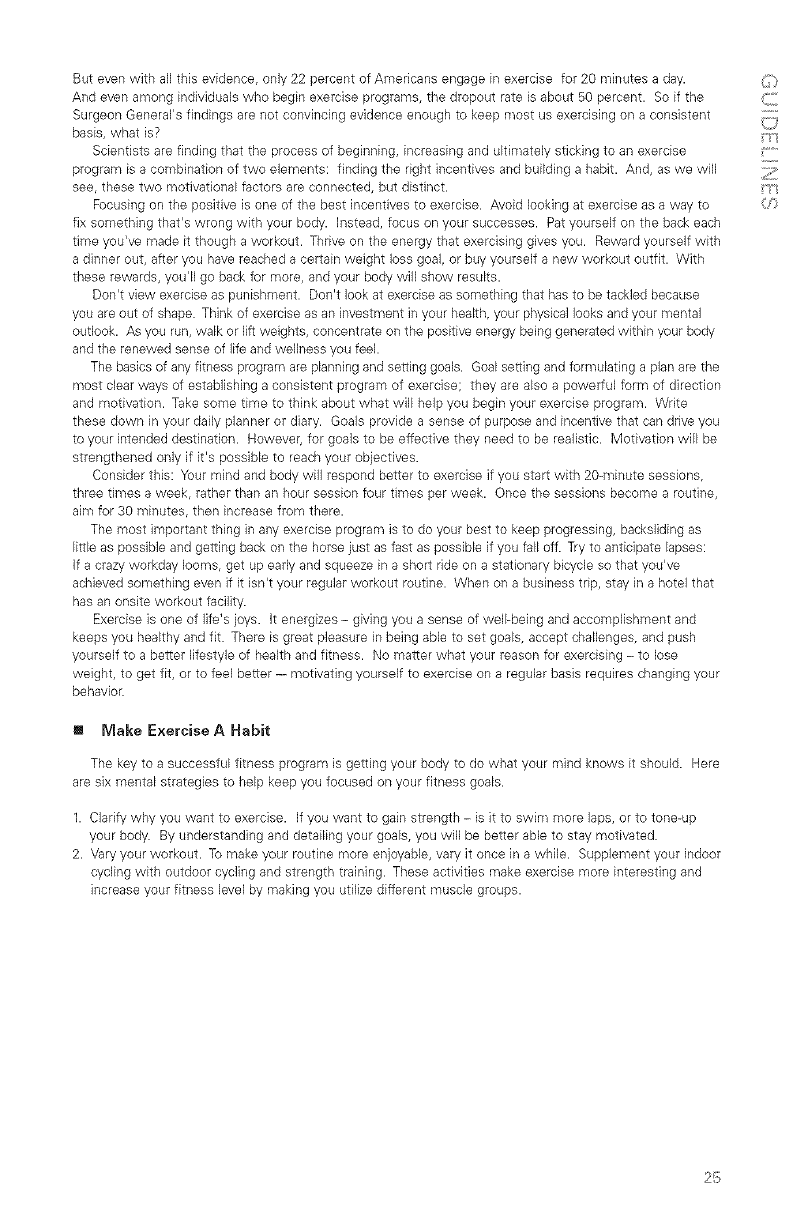
But even with all this evidence, only 22 percent of Americans engage in exercise for 20 minutes a day.
And even among individuals who begin exercise programs, the dropout rate is about 50 percent. So if the
Surgeon General's findings are not convincing evidence enough to keep most us exercising on aconsistent
basis, what is7
Scientists are finding that the process of beginning, increasing and ultimately sticking to an exercise
program is a combination of two elements: finding the right incentives and building a habit. And, as we will
see, these two motivational factors are connected, but distinct.
Focusing on the positive is one of the best incentives to exercise. Avoid looking at exercise asa way to
fix something that's wrong with your body. Instead, focus on your successes. Pat yourself on the back each
time you've made it though a workout. Thrive on the energy that exercising gives you. Reward yourself with
a dinner out, after you have reached a certain weight loss goal, or buy yourself a new workout outfit. With
these rewards, you'll go back for more, and your body will show results.
Don't view exercise as punishment. Don't look at exercise as something that has to be tackled because
you are out of shape. Think of exercise as an investment in your health, your physical looks and your mental
outlook. As you run, walk or lift weights, concentrate on the positive energy being generated within your body
and the renewed sense of life and wellness you feel.
The basics of any fitness program are planning and setting goals. Goal setting and formulating aplan are the
most clear ways of establishing a consistent program of exercise; they are also a powerful form of direction
and motivation. Take some time to think about what will help you begin your exercise program. Write
these down in your daily planner or diary. Goals provide a sense of purpose and incentive that can drive you
to your intended destination. However, for goals to be effective they need to be realistic. Motivation will be
strengthened only if it's possible to reach your objectives.
Consider this: Your mind and body will respond better to exercise if you start with 20-minute sessions,
three times a week, rather than an hour session four times per week. Once the sessions become a routine,
aim for 30 minutes, then increase from there.
The most important thing in any exercise program is to do your best to keep progressing, backsliding as
little as possible and getting back on the horse just as fast aspossible if you fall off. Try to anticipate lapses:
If a crazy workday looms, get up early and squeeze in a short ride on astationary bicycle so that you've
achieved something even if it isn't your regular workout routine. When on a business trip, stay in a hotel that
has an onsite workout facility.
Exercise is one of life's ioys. It energizes - giving you a sense of well-being and accomplishment and
keeps you healthy and fit. There is great pleasure in being able to set goals, accept challenges, and push
yourself to a better lifestyle of health and fitness. No matter what your reason for exercising - to lose
weight, to get fit, or to feel better -- motivating yourself to exercise on a regular basis requires changing your
behavior.
! Make Exercise A Habit
The key to a successful fitness program isgetting your body to do what your mind knows it should. Here
are six mental strategies to help keep you focused on your fitness goals.
1. Clarify why you want to exercise. If you want to gain strength - is it to swim more laps, or to tone-up
your body. By understanding and detailing your goals, you will be better able to stay motivated.
2. Vary your workout. To make your routine more enjoyable, vary it once in a while. Supplement your indoor
cycling with outdoor cycling and strength training. These activities make exercise more interesting and
increase your fitness level by making you utilize different muscle groups.
25


















